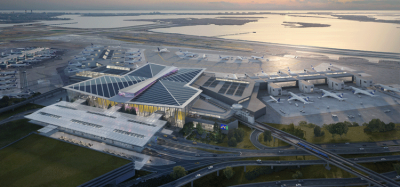Development of Orlando’s South Terminal complex reaches next design benchmark
- Like
- Digg
- Del
- Tumblr
- VKontakte
- Buffer
- Love This
- Odnoklassniki
- Meneame
- Blogger
- Amazon
- Yahoo Mail
- Gmail
- AOL
- Newsvine
- HackerNews
- Evernote
- MySpace
- Mail.ru
- Viadeo
- Line
- Comments
- Yummly
- SMS
- Viber
- Telegram
- Subscribe
- Skype
- Facebook Messenger
- Kakao
- LiveJournal
- Yammer
- Edgar
- Fintel
- Mix
- Instapaper
- Copy Link
Posted: 21 February 2017 | | No comments yet
Construction activity will begin soon on the $1.8 billion South Terminal Complex (STC) Phase 1 Terminal C at Orlando International Airport…


As the project advances toward the anticipated building phase, the design phase is nearly two-thirds complete. The design team of Fentress Architects, HNTB and SchenkelShultz recently reached the 60 percent threshold, with only two design benchmarks remaining.
The airport has also featured recently in the news with a weird and not-so-wonderful tortoise problem which you can read here…
Traditionally, construction projects set completion targets at 30, 60, 90 and 100 percent. Design elements are being refined following lead architect Curt Fentress’ presentation to the Greater Orlando Aviation Authority board in November.
The Board’s approval of his initial concepts sent the project moving forward toward final design completion. With many customer-friendly innovations, Fentress’ overall plan incorporates beauty, efficiency and convenience.
The STC design reinforces a campus vision by focusing on a unifying theme called “The Boulevard”.
The Boulevard is a corridor that runs the length of the terminal and connects the major civic areas, including the ticket hall and concessions hub. Other innovative aspects of the STC include:
- Unique top-level customer arrival experience — Arrivals and bag claim will be located on the third level so passengers will experience the beauty of Central Florida immediately after deplaning. Departures, ticketing and security will be located on the second level and ground transportation on the first level.
- State-of-the-art Baggage Handling System — Radio Frequency Identification (RFID) technology will offer 100% baggage tracking. Faster than conventional baggage conveyors. Modularity will allow for future expansion. Lower life-cycle cost.
- Dynamic concessions — More concessions will be located beyond security. Club/Lounge opportunities will be available along with a “concessions in the park” area.
- Imaginative multi-media experience — Interactive video displays will be featured in the ticket hall and concessions hub.
“We’re looking to create a new gateway for Orlando, one that captures the essence of Central Florida and enhances The Orlando Experience,” said Phil Brown, Executive Director of the Greater Orlando Aviation Authority.
“The South Terminal is designed to be intuitive so the passenger is drawn from one element to the next, creating an exciting and memorable arrival into the city of Orlando.”
The first phase of the South Terminal Complex will feature 16 gates with a flexible configuration that will be able to accommodate narrow body, jumbo and super jumbo aircraft. Construction is set to begin in the first quarter of 2017 with projected completion in 2020. Additional details about the STC include:
- The STC and associated apron/taxiway will encompass approximately 300 acres
- The total building program will comprise approximately 2.7 million square feet
- The STC will serve both international and domestic flights
- Complex will include an expanded parking garage
- Will follow the Sustainable Management Plan (SMP) for a planned LEED Version 4 New Construction project
For more than 30 years, the cornerstone of the Greater Orlando Aviation Authority’s (GOAA) development philosophy has been building in phases to meet demand. With passenger traffic continuing to reach record levels, currently at nearly 42 million annually, Orlando International Airport is engaging in multiple construction projects. Key elements of the Aviation Authority’s $3 billion Capital Improvement Plan (CIP) are in various stages of activity and when ultimately completed, will enhance operational efficiency, accommodate growth and expand accessibility.
The multi-year plan of major capital projects is based on expected annual passengers and is linked to GOAA’s strategic goals developed from the Authority’s Master Plan process.

















